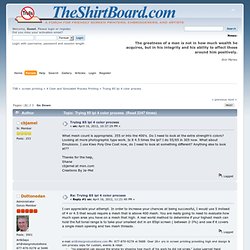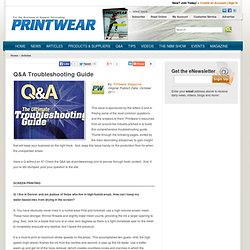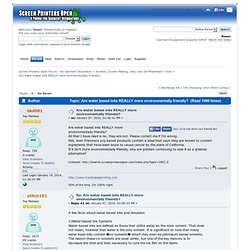

Garment Printing. News - Stitch & Print. Stitch & Print - Business magazine for professional embroiderers, textile printers and garment decorators, formely Eurostitch. BuYprint - produkcja odzieży, nadruk, haft. Droplet Printing: Eco-friendly screen printing services. AEM MERCHANDISING / custom apparel manufacturer and decorator company. Screen Printing - April/May 2013. Halftonedefstudios' Photostream. Choosing LPI For Output. This is a very, very common question and there's usually some "machoism" associated with it. You know, I can print 85 lpi all day, and so on.
Here are some things to consider. Just because you can print a finer dot, doesn't mean you should. This will be the first of several posts on choosing lpi based on production considerations and related factors. The choice of LPI for your halftone is determined by several factors. Substrate Limitations.Viewing Distance.Screen stencil resolving capabilities.Production variables (mainly moire and dot gain.) The coarser the dot you choose, the easier it's going to be to make an accurate stencil, control moire, dot gain, and tonal range reproduction. On the flip side, the finer the dot, the more detail you can hold and the less noise the image will have (surface texture that interferes with the image.)
For textiles, the most common ranges fall between 45 lpi and 85 lpi. First and foremost, consider the "dot density". Ellipse Vrs Dot shape benefit "example attached" [I believe that one the underlying problems is that the ratio isn't "really" changing, just the shape of the dot within the cell.

Attached is shape i've created, but have not had the time to test. This example is a round dot halftone at a 2:1 film ratio. This results is elliptical dots oriented to the horizon (regardless of angle). The horizontal elliptical dots are intended to counteract textile moire. SolutionsJournal. By Bill Hood • May 21, 2012 Annual Subscription is only $14.95 You will gain access to over 500 articles on the screenprinting process currently in our archives. Yes, that comes out to less than $0.02 each. And, we continue to add more articles continuously. That is the best return on investment that you will ever get from anyone. Trying 85 lpi 4 color process. Doing some quick and dirty math, at 85 LPI one "cell" for a dot is about 300 micron square, and isn't 3% @ 85LPI a less-than sixty micron dot?

I'm not sure what you mean by 85lpi (cell). Are you referring to mesh opening or the cell used (in your printer) to plot out how many spits of ink onto the films in a given location to fill the needed space to make up a dot? Most "digital printers" are not 100% accurate when outputting dot %. So, the typical digital films 85lpi 3% dots might be as much as 50% larger that a "real life" 3% dot.
Then again, what is "real life". The 420-30 Murakami smart mesh has a 30 micron thread and a 30 micron opening and results in a 25% open area (so they say). Not that you'd measure this all that accurately, but your smallest halftone dot would have to be in the area of 2 mesh threads and one mesh opening to (get as much tonal range as you can get). Pdf_server.cfm (Objet application/pdf) SkatRadioh's Photostream. Q&A Troubleshooting Guide. This issue is sponsored by the letters Q and A.

Posing some of the most common questions and the answers to them, Printwear’s resources from all around the industry pitched in to build this comprehensive troubleshooting guide. Thumb through the following pages, sorted by the main decorating disciplines, to gain insight that will keep your business on the right track. And, keep this issue handy on the production floor for when the unexpected arises. Telescope // Art Print. Telescope // Art Print September 12th, 2012 // Posted by Dan in Art Print, Blog, DKNG Work, Explosions In The Sky, Illustration.

Technique Development by MTB Creative (Meg Triffitt Ball) at Coroflot. Screen Printing Chicago. Behind the Curtain at a T-shirt Shop. Best water-based textile ink. The Register Guide: Technical Fundamentals in Screen Printing to Eliminate ... - Mike Young. Paper Prep. Four-Color Process Printing. If you’re either very new or very old in this business, you’ll have come across four-color process (4CP) printing.

For those who are very experienced (20 years or more), 4CP or CMYK printing was the only real way of achieving photo-realistic reproduction. For more than 150 years, this was the way all full-color printing was done for all printing processes. 4CP history Right from the beginning, I’d like to clarify a major misconception about process color. It may be referred to as full-color printing but, in reality, it is far from full color. A healthy human will see somewhere between six and 10 million colors and tones depending on age and gender. For those new to the industry, CMYK or process color reproduction is experiencing somewhat of a renaissance. All digital printing is CMYK or true process color reproduction. For inkjet or digital reproduction, it’s very common to have even more. Controlling the process Pick images that have a wide range of color and tone (light to dark). Are water based inks REALLY more environmentally friendly? - Screen Printers Open - A Forum for Screen Printing and Embroidery.
No, water based inks are not more environmentally friendly than plastisol.

The history of water based inks, was as a replacement or solvent based inks. This primarily involved paper printing. When printing a product, such as newspapers, the ink is predominantly a solvent and is consumed by the barrel. Contact & liens - jeronimo.dk. Amélie Graphiste. PAN!